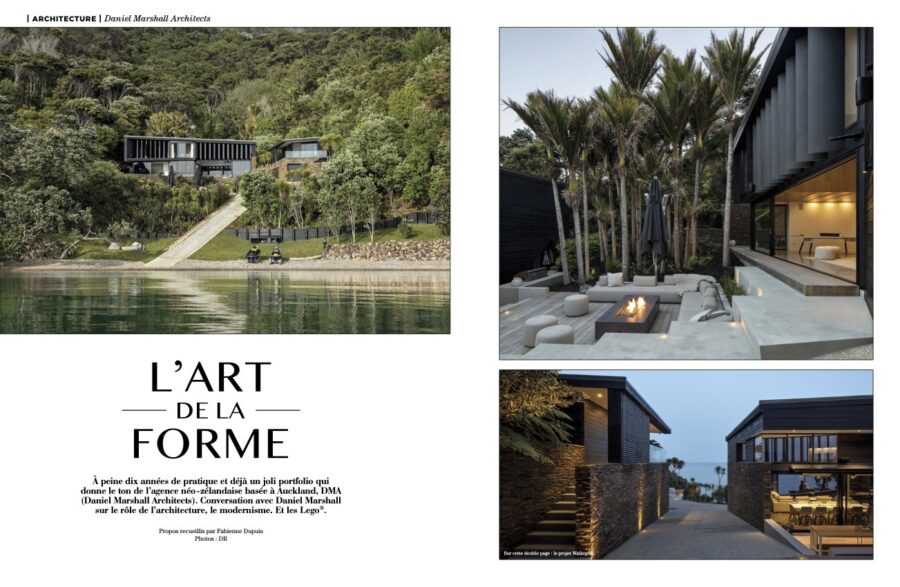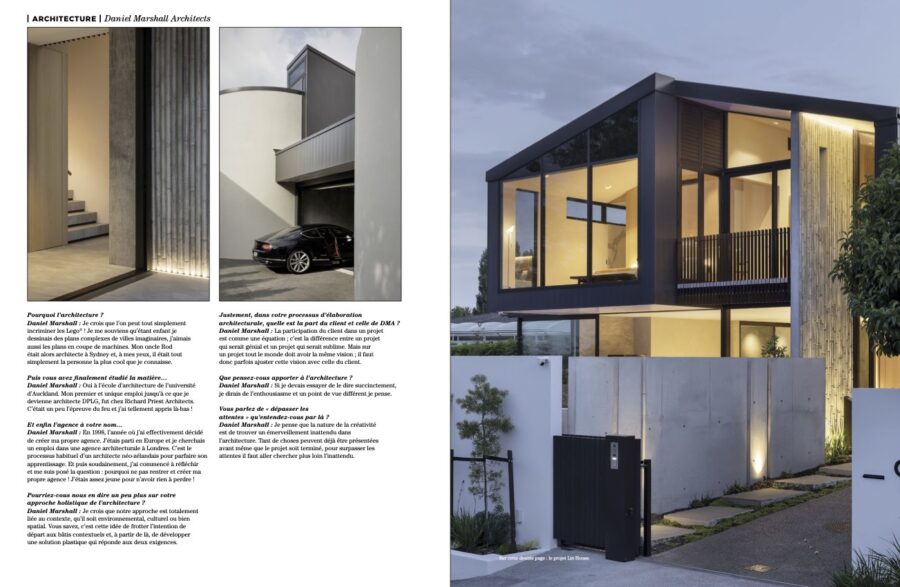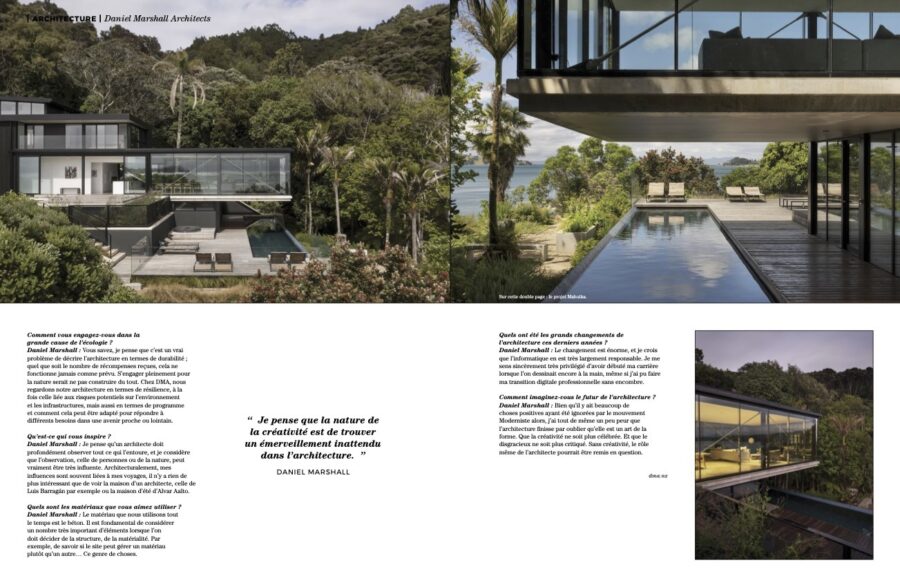We are so excited to be featured in Artravel's latest magazine issue. The feature interview with Daniel explores his's outlook and design philosophy on Architecture.
Artravel is a French magazine that curates the finest & current designs from around the world. Since we don't speak French, we have google translated the highlights of the interview for you =).

Google Translate :
Why architecture? Daniel Marshall: I think we can quite simply incriminate Lego®! I remember that as a child I drew complex plans of imaginary cities, I also liked sectional plans of machines. My Uncle Rod was an architect in Sydney at the time and, to me, he was just the coolest person I knew.
Then you finally studied the subject... Daniel Marshall: Yes at the School of Architecture at the University of Auckland. My first and only job before becoming a DPLG Architect was with Richard Priest Architects. It was a bit of a trial by fire and I learned so much there!
And finally the agency in your name... Daniel Marshall: In 1998, the year I actually decided to create my own agency. I had gone to Europe and was looking for a job in an architectural firm in London. This is the usual process for a New Zealand architect to complete his apprenticeship. And then suddenly, I started to thinking and asked myself the question: why not go back and create my own agency! I was young enough to have nothing to lose!
Could you tell us a bit more about your holistic approach to architecture? Daniel Marshall: I believe that our approach is totally linked to the context, be it environmental, cultural or spatial. You know, it's this idea of rubbing the original intention to the contextual frames and, from there, developing a plastic solution that meets both requirements.
Precisely, in your architectural development process, what is the part of the client and that of DMA? Daniel Marshall: The client's participation in a project is like an equation; it's the difference between a project that could be great and a project that could be sublime. But on a project, everyone must have the same vision; it is therefore sometimes necessary to adjust this vision with that of the client.
What do you think you bring to architecture? Daniel Marshall: If I had to try to put it succinctly, I would say enthusiasm and a different point of view I think.
You talk about “exceeding expectations” what do you mean by that? Daniel Marshall: I think the nature of creativity is to find unexpected wonder in architecture. So much can be presented even before the project is finished, to exceed expectations you have to look further for the unexpected.
How do you get involved in the great cause of ecology? Daniel Marshall: You know, I think it's a real problem to describe architecture in terms of durability; no matter how many rewards you receive, it never works as intended. To fully commit to nature would be not to build at all. At DMA, we look at our architecture in terms of resilience, both related to potential risks to the environment and infrastructure, but also in terms of the program and how it can be adapted to meet different needs in the near or distant future.
What inspires you? Daniel Marshall: I think an architect has to deeply observe everything around them, and I think observation, whether of people or of nature, can really be very influential. Architecturally, my influences are often linked to my travels, there is nothing more interesting than seeing the house of an architect, that of Luis Barragán for example or the summer house of Alvar Aalto.
What materials do you like to use? Daniel Marshall: The material we use all the time is concrete. It is fundamental to consider a very large number of factors when deciding the material used in the structure. For example, whether the site can handle one material over another... That sort of thing.
What have been the major changes in architecture in recent years? Daniel Marshall: The change is enormous, and I believe that IT is very largely responsible for it. I sincerely feel very privileged to have started my career when we were still drawing by hand, even if I was able to make my professional digital transition without a hitch.
How do you imagine the future of architecture? Daniel Marshall: Although there were many positive things that were ignored by the Modernist movement back then, I am still a little afraid that architecture will end up forgetting that it is an art of form and that creativity will no longer be celebrated. And that the unsightly are no longer criticised. Without creativity, the very role of the architect could be called into question.


Original interview in french :
Pourquoi l’architecture ? Daniel Marshall : Je crois que l’on peut tout simplement incriminer les Lego® ! Je me souviens qu’étant enfant je dessinais des plans complexes de villes imaginaires, j’aimais aussi les plans en coupe de machines. Mon oncle Rod était alors architecte à Sydney et, à mes yeux, il était tout simplement la personne la plus cool que je connaisse.
Puis vous avez finalement étudié la matière... Daniel Marshall : Oui à l’école d’architecture de l’université d’Auckland. Mon premier et unique emploi jusqu’à ce que je devienne architecte DPLG, fut chez Richard Priest Architects. C’était un peu l’épreuve du feu et j’ai tellement appris là-bas !
Et enfin l’agence à votre nom... Daniel Marshall : En 1998, l’année où j’ai effectivement décidé de créer ma propre agence. J’étais parti en Europe et je cherchais un emploi dans une agence architecturale à Londres. C’est le processus habituel d’un architecte néo-zélandais pour parfaire son apprentissage. Et puis soudainement, j’ai commencé à réfléchir et me suis posé la question : pourquoi ne pas rentrer et créer ma propre agence ! J’étais assez jeune pour n’avoir rien à perdre !
Pourriez-vous nous en dire un peu plus sur votre approche holistique de l’architecture ? Daniel Marshall : Je crois que notre approche est totalement liée au contexte, qu’il soit environnemental, culturel ou bien spatial. Vous savez, c’est cette idée de frotter l’intention de départ aux bâtis contextuels et, à partir de là, de développer une solution plastique qui réponde aux deux exigences.
Justement, dans votre processus d’élaboration architecturale, quelle est la part du client et celle de DMA ? Daniel Marshall : La participation du client dans un projet est comme une équation ; c’est la différence entre un projet qui serait génial et un projet qui serait sublime. Mais sur un projet tout le monde doit avoir la même vision ; il faut donc parfois ajuster cette vision avec celle du client.
Que pensez-vous apporter à l’architecture ? Daniel Marshall : Si je devais essayer de le dire succinctement, je dirais de l’enthousiasme et un point de vue différent je pense.
Vous parlez de « dépasser les attentes » qu’entendez-vous par là ? Daniel Marshall : Je pense que la nature de la créativité est de trouver un émerveillement inattendu dans l’architecture. Tant de choses peuvent déjà être présentées avant même que le projet soit terminé, pour surpasser les attentes il faut aller chercher plus loin l’inattendu.
Comment vous engagez-vous dans la grande cause de l’écologie ? Daniel Marshall : Vous savez, je pense que c’est un vrai problème de décrire l’architecture en termes de durabilité ; quel que soit le nombre de récompenses reçues, cela ne fonctionne jamais comme prévu. S’engager pleinement pour la nature serait ne pas construire du tout. Chez DMA, nous regardons notre architecture en termes de résilience, à la fois celle liée aux risques potentiels sur l’environnement et les infrastructures, mais aussi en termes de programme et comment cela peut être adapté pour répondre à différents besoins dans une avenir proche ou lointain.
Qu’est-ce qui vous inspire ? Daniel Marshall : Je pense qu’un architecte doit profondément observer tout ce qui l’entoure, et je considère que l’observation, celle de personnes ou de la nature, peut vraiment être très influente. Architecturalement, mes influences sont souvent liées à mes voyages, il n’y a rien de plus intéressant que de voir la maison d’un architecte, celle de Luis Barragán par exemple ou la maison d’été d’Alvar Aalto.
Quels sont les matériaux que vous aimez utiliser ? Daniel Marshall : Le matériau que nous utilisons tout le temps est le béton. Il est fondamental de considérer un nombre très important d’éléments lorsque l’on
doit décider de la structure, de la matérialité. Par exemple, de savoir si le site peut gérer un matériau plutôt qu’un autre... Ce genre de choses.
Quels ont été les grands changements de l’architecture ces derniers années ? Daniel Marshall : Le changement est énorme, et je crois que l’informatique en est très largement responsable. Je me sens sincèrement très privilégié d’avoir débuté ma carrière lorsque l’on dessinait encore à la main, même si j’ai pu faire ma transition digitale professionnelle sans encombre.
Comment imaginez-vous le futur de l’architecture ? Daniel Marshall : Bien qu’il y ait beaucoup de choses positives ayant été ignorées par le mouvement Moderniste alors, j’ai tout de même un peu peur que l’architecture finisse par oublier qu’elle est un art de la forme. Que la créativité ne soit plus célébrée. Et que le disgracieux ne soit plus critiqué. Sans créativité, le rôle même de l’architecte pourrait être remis en question.





